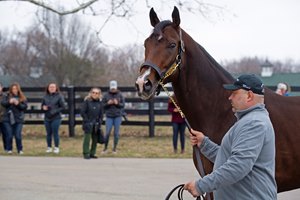Omaha Beach Settles in at Spendthrift Farm


Multiple grade 1 winner Omaha Beach made his first public appearance since being retired from racing five days ago to a gathering of breeders and fans Jan. 28 at Spendthrift Farm.
The ease with which the fit, 4-year-old son of War Front walked and posed outside a quarantine barn near the farm's stallion complex, taking casual interest in his new surroundings, provided ample evidence that his transition from elite racehorse to stallion should be a smooth one.
Omaha Beach's transition to stud duty is following the same compressed schedule taken by a few others since The Stronach Group introduced the Pegasus World Cup Invitational Stakes (G1) at Gulfstream Park in January of 2017 with a $12 million purse. The big-money race provided a strong incentive to keep top colts in training, but it also required negotiating a compressed transition period into the breeding season that begins the second week in February. Prior to the Pegasus, entering-year stallions got a couple of months to make this transition.
Taylor Made Stallions' former sire California Chrome was the pioneer for this compressed schedule in 2017 and proved it could be managed successfully. Three Chimneys Farm's Gun Runner and Lane's End's City of Light followed the same program in 2018 and 2019, respectively, with equally successful results.
A high degree of intelligence and adaptability are traits that Omaha Beach shares with these other three stallions.
"He has a great mind and great attitude," said Ned Toffey, general manager for Spendthrift. "It is hard to believe this horse, after shipping across the country, rolled in here at 7 o'clock last night, we pulled his bell boots off, threw a blanket on him, he sniffed around a little bit, and then started eating hay. He has settled in as well as you could ask any horse to do."
Omaha Beach's transition is slightly complicated by a right, rear ankle injury that forced him to be scratched out of the Pegasus World Cup on the Thursday prior to the Jan. 25 race. Swelling in the ankle was detected and subsequent radiographs showed early indications of a cannon bone fracture.
"Because of his injury, we're waiting on the vets' reports to see how long he might need to be restricted and when we can start increasing the exercise," Toffey said. "Right now, the ankle is tight, and he's walking sound."
Toffey added that even if Omaha Beach had not injured an ankle, his let-down routine would not be much different. For any horse transitioning from racing to farm life, Spendthrift uses portable panels to create a restricted space in a paddock—basically an open-air stall with access to grass. Omaha Beach will be hand-walked and spend time in this pen getting accustomed to his surroundings. Panels will be added to the pen over time and gradually expanded to the size of a round pen before the horse will be allowed free access within a paddock.
"With any new horse, you watch them like a hawk when they come in," Toffey said. "You start off with a plan, but everything in horse business is all day-to-day. We go to great lengths to make sure they settle in."
As for stud duty, Toffey said Omaha Beach will dictate the pace with this transition as well.
"We are cautiously optimistic he'll be on schedule, or close to it, for the start of breeding season. We'll make sure the timing is right and not rush him. If we have to wait a bit longer, then we'll wait," he said.

Spendthrift Farm will open its breeding shed Feb. 10. Omaha Beach, who is standing for $45,000, already has his book full for this year's breeding season, during which he is expected to cover just over 200 mares.
